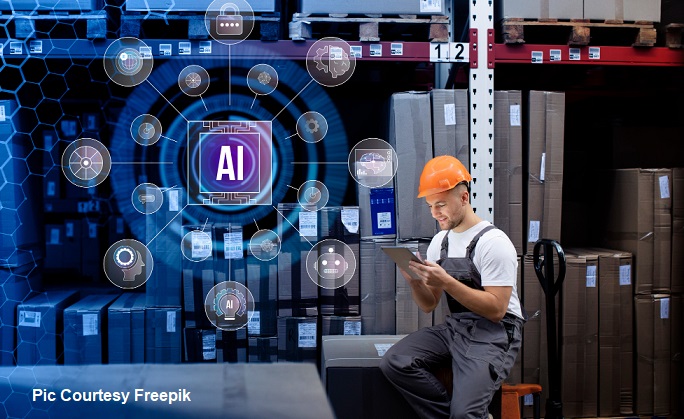by Edward Chow
In just over 12 months, generative AI has taken the world by storm, impacting people from all walks of life in more profound ways than many technologies before.
What is clear, despite the uncertainties in the next 12 months, is that AI will continue to drive the way technology is being used to create new value and efficiencies. AI is still in its infancy and like the internet of the 1990’s, there will likely be many more creative applications that are pushing the boundaries of imagination.
From transportation to manufacturing to financial sectors, businesses can expect the use of more AI in everyday scenarios, including those involving mission-critical systems.
As the IT and operating technology (OT) worlds continue to merge, AI will drive a lot of the transformation in and acceleration towards Industry 4.0. Here are five trends that businesses should be aware of:
1. AI to drive data usage
While much of the focus has been on the compute power needed to train AI models, the transformation that the technology brings is also dependent on the fuel needed for any digitalization effort – data, lots and lots of data.
Without enough data and more specifically, the right kind of data, AI cannot fulfill its promise to improve efficiency and open up new opportunities.
For many enterprises, what this means is the need to not only accelerate their efforts in creating a data warehouse but also develop digital transformation with plenty of quality data for AI model training. With the right data, AI can help analyze past issues at an oil rig, for example, and provide answers to operators seeking to overcome challenges today.
The same applies to video and image analytics as well. Used often for security and safety, the visual data needs to be available for AI to be trained on to be more precise in its predictions and analysis.
As 2024 progresses, enterprises that rely on industrial automation for their everyday tasks will seek to make better use of the data they have on hand. They have to better capture, store and transmit that data, through more modern infrastructure, for AI to work at its best.
2. Edge computing for modernization
Many enterprises, unfortunately, still do not have the infrastructure needed for the transformation needed for modern automation and edge computing. This is especially true of many enterprises that operate in industrial settings, for example, in the oil and gas, manufacturing, metals, public transport and other sectors.
Increasingly, many will see the importance of coming up to speed with more modern information infrastructure in place, starting with the edge computing performance that is badly in need of an upgrade to tap on what AI can offer.
Whether this is for a steel plant or mineral refinery in a remote part of the world, edge computing with adequate performance not only connects the data close to the source but also analyzes it locally for use quickly, perhaps even in real time.
Again, the importance of data is clear here. Without a modern edge computing setup, ageing systems will not be able to handle, let alone make use of, the all-important data from sensors and machine metrics that enable data-driven decision making. As such, Edge computing is a prerequisite for the preparation of AI applications at the Edge.
3. Fault tolerance is not a luxury any more
Many enterprises that operate in industrial settings are ones that operate around the clock. A discrete manufacturing plant, for example, needs to maximize output by being always-on, which is similar to an oil refinery that has to be monitored round the clock.
For many such enterprises, customer expectations have risen with competition as well. Similarly, the ever-increasing pressure to improve yield and boost efficiency means that downtime has become costlier each year.
This means enterprises will increasingly look to fault tolerance and high availability as important business priorities, especially in competitive fields where every second counts.
These enterprises need availability at least in the five 9s to be competitive, not just a cold backup that needs hours or even days to restore in the event of any unscheduled downtime. Enterprises that reduce disruption an always-on strategy have an excellent chance to leapfrog rivals and increase market share as a result.
4. Industrial automation at scale
From automated guided vehicles (AGVs) that deliver goods within a shipyard or warehouse to video analysis that helps improve quality control and yield, enterprises are finding that it is often tougher and less productive to upgrade parts of their infrastructure in a piecemeal fashion.
In the AGV example, the enterprise would not only have to ensure its AGVs are well connected but also enable the data they transmit to be precise and quickly analyzed. This means more than simply buying an AGV solution but overhauling and modernizing a large part of the IT/OT infrastructure as well.
The same can be said of video analytics. With an edge computing system that is able to deliver insights quickly and in a timely manner, operators and managers can quickly recalibrate their machinery on a manufacturing floor to improve quality, boost yield and reduce wastage of materials.
This is smarter than sending the data to the cloud to be slowly “crunched” before having it back hours or days later, when the impact would have been delayed or reduced. Having a recursive feedback loop for real-time operation optimization is a strong competitive advantage for the bottom line.
What’s clear is that more enterprises will seek to digitalize and move up to the next level of industrial automation at scale. While some enterprises may prefer a step-by-step approach over time, the long-term strategy would have to involve modernizing IT/OT infrastructure at scale.
5. Remote control with low-latency networks
One important improvement that has occurred in recent years is the availability of high-speed, low-latency wireless networks in the form of Wi-Fi 6 and 5G. As Wi-Fi 7 begins shipping and research and trials continue to advance in 6G, enterprises will see more use cases with such low-latency networks enabling new digital innovations.
A near-instantaneous video feed delivered wirelessly will enable a factory floor to run real-time quality checks as products are being made on an assembly line. This is possible with on-the-fly video analytics performed by edge computing systems that are up to the task.
Such low-latency networks are also increasingly important and common in enterprises that run AGVs or other forms of automation. For example, warehouses or shipyards will take advantage of such wireless networks to enable not just AGVs but also drones in future for surveillance, security and even short-distance deliveries.
With technologies such as Wi-Fi 6 and 5G becoming mature and well tested this year, more enterprises will set them up as part of a modernization effort to take advantage of complementary technologies such as data analytics and AI.
AI and the power of cumulative knowledge
As mentioned above, AI applications are data-hungry and it is crucial to have an information infrastructure that supports such quality data feeds.
Similar to a human brain, AI applications will continue to learn and improve with operation data coming in day after day, adding to what they have already learnt from earlier data. This cumulative knowledge is powerful for developing expertise in different mission-critical domains.
Despite rapid recent developments, we are just scratching the surface for AI applications. That said, it is not hard to foresee the power of AI in transforming the way goods are manufactured, how quality checks are performed, how operations are scheduled, how decisions are made, and fundamentally, how we do business for years to come.


